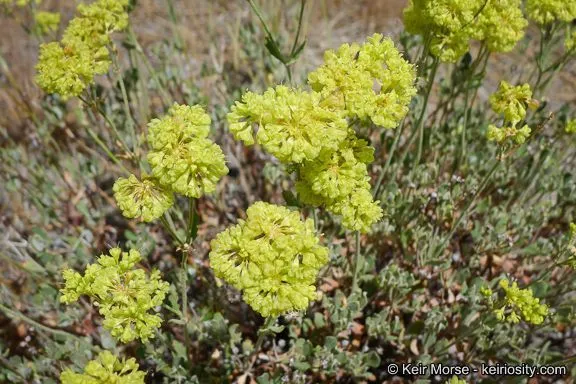
Author: Torr.
Bibliography: Ann. Lyceum Nat. Hist. New York 2: 241 (1827)
Year: 1827
Status: accepted
Rank: species
Genus: Eriogonum
Vegetable: False
Observations: NW. U.S.A. to New Mexico
Sulfur-buckwheat, scientifically known as Eriogonum umbellatum, is a fascinating and resilient perennial plant belonging to the Polygonaceae family. This plant was first documented in the publication “Annals of the Lyceum of Natural History of New York” in 1827, thanks to the work of renowned botanist John Torrey.
Native to regions spanning from the Northwestern United States to New Mexico, sulfur-buckwheat thrives in diverse habitats including mountainous areas, sagebrush zones, and open woodlands. Adapted to survive in these varied environments, Eriogonum umbellatum demonstrates impressive tolerance to different soil types, including those that are low in nutrients.
One of the most remarkable features of this plant is its vibrant sulfur-yellow flowers. Blooming in the late spring to summer, these flowers are arranged in dense, umbrella-like clusters sitting atop erect stems that can reach up to 30 centimeters in height. The foliage consists of basal rosettes of elliptic to oblong leaves, which are often covered with a woolly texture, giving the plant a distinctive grey-green appearance. This adaptation helps reduce water loss, making sulfur-buckwheat particularly suited for the arid conditions it often inhabits.
Sulfur-buckwheat plays a crucial role in the ecosystem, providing nectar and pollen for a variety of pollinators, including bees, butterflies, and other insects. Additionally, it serves as an important food source for some caterpillar species. Because of its attractive flowers and foliage, Eriogonum umbellatum is also a popular choice for native plant gardens and restoration projects, offering both aesthetic value and ecological benefits.
Cultivating sulfur-buckwheat in a garden setting can be relatively straightforward, provided its basic needs are met. It prefers full sun to partial shade and well-drained soil. Once established, the plant requires minimal watering, showcasing its drought-resistant qualities. Gardeners appreciate its low-maintenance nature and the splash of color it brings to rock gardens and borders.
In summary, Eriogonum umbellatum, or sulfur-buckwheat, is a noteworthy plant celebrated for its hardiness, ecological contributions, and striking floral displays. Its presence in the wild and in cultivated gardens underscores the beauty and utility of native plant species within the Polygonaceae family.
Eng: sulfur buckwheat, sulfur eriogonum, sulfur-buckwheat, sulphur flower buckwheat, sulphur wildbuckwheat, sulphur-flower, sulphur-flower buckwheat, sulphur-flowered buckwheat, sulphur buckwheat, sulphur-flowered wild buckwheat, sulphurflower
Swe: svavelullslide
Fra: ériogone à ombelle
En: Sulfur-buckwheat, Sulphur-flower, Sulphur-flower buckwheat, SULFUR ERIOGONUM, Sulfur buckwheat, Sulphur wildbuckwheat, Sulphurflower buckwheat, Sulphur flower buckwheat, Sulphur-flowered buckwheat, Sulphur buckwheat, Sulphur-flowered wild buckwheat, Sulphurflower
Fi: Rikkipumissi
Fr: Ériogone à ombelle
Pl: Pokoślin baldaszkowaty
Sv: Svavelullslide
© copyright of the Board of Trustees of the Royal Botanic Gardens, Kew.
© copyright of the Board of Trustees of the Royal Botanic Gardens, Kew.
© copyright of the Board of Trustees of the Royal Botanic Gardens, Kew.
Taken Aug 19, 2015 by EOL − Keir Morse (cc-by-nc-sa)
Taken Aug 19, 2015 by EOL − Keir Morse (cc-by-nc-sa)
Taken Aug 19, 2015 by EOL − Keir Morse (cc-by-nc-sa)
Taken Jul 10, 2020 by jeffrey hinz (cc-by-sa)
Taken Aug 19, 2021 by Danielle Mccloy (cc-by-sa)
Taken Aug 4, 2022 by Shawna Davis (cc-by-sa)
Taken Aug 19, 2021 by Danielle Mccloy (cc-by-sa)
Taken Jul 25, 2009 by Tela Botanica − Yoan MARTIN (cc-by-sa)
Taken Jul 25, 2009 by Tela Botanica − Yoan MARTIN (cc-by-sa)
Taken Jul 15, 2021 by lianawelty (cc-by-sa)
Taken Aug 1, 2019 by yousch (cc-by-sa)
Taken Aug 19, 2015 by EOL − Keir Morse (cc-by-nc-sa)
Taken Aug 25, 2010 by EOL − Steve Matson (cc-by-nc)
Taken Aug 19, 2015 by EOL − Keir Morse (cc-by-nc-sa)
Taken Aug 19, 2015 by EOL − Keir Morse (cc-by-nc-sa)
Taken Aug 19, 2015 by EOL − Keir Morse (cc-by-nc-sa)
Taken Aug 19, 2015 by EOL − Keir Morse (cc-by-nc-sa)
Taken Aug 19, 2015 by EOL − Keir Morse (cc-by-nc-sa)
Taken Aug 19, 2015 by EOL − Keir Morse (cc-by-nc-sa)
Taken Nov 13, 2002 by EOL − Dr. Robert T. and Margaret Orr (cc-by-nc-sa)
Growth form: Multiple Stem
Growth habit: Subshrub, Shrub, Forb/herb
Growth rate: Slow
Ph maximum: 8.0
Ph minimum: 6.5
Family: Myrtaceae Author: (F.Muell.) K.D.Hill & L.A.S.Johnson Bibliography: Telopea 6: 402 (1995) Year: 1995 Status:…
Family: Rubiaceae Author: Pierre ex A.Froehner Bibliography: Notizbl. Bot. Gart. Berlin-Dahlem 1: 237 (1897) Year:…
Family: Sapindaceae Author: Koidz. Bibliography: J. Coll. Sci. Imp. Univ. Tokyo 32(1): 38 (1911) Year:…
Family: Asteraceae Author: A.Gray Bibliography: Pacif. Railr. Rep.: 107 (1857) Year: 1857 Status: accepted Rank:…
Family: Fabaceae Author: Medik. Bibliography: Vorles. Churpfälz. Phys.-Ökon. Ges. 2: 398 (1787) Year: 1787 Status:…
Family: Aspleniaceae Author: (Cav.) Alston Bibliography: Bull. Misc. Inform. Kew 1932: 309 (1932) Year: 1932…